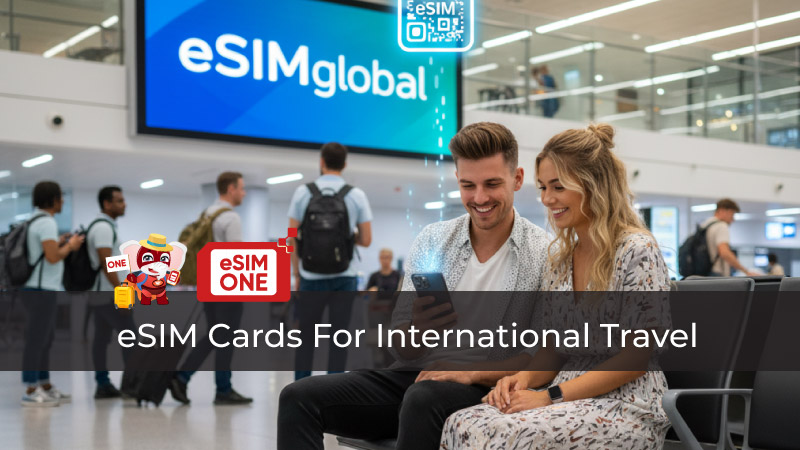eSIM Cards for International Travel Complete Guide 2025

eSIM cards for international travel digital connectivity
eSIM cards for international travel have revolutionized how travelers stay connected globally, eliminating the need for physical SIM cards while offering seamless connectivity across 200+ destinations. Modern travelers increasingly choose eSIM cards for international travel over traditional roaming due to cost savings up to 50%, instant activation via QR codes, and the convenience of managing multiple data plans simultaneously. This comprehensive guide explores everything you need to know about selecting and using eSIM cards for international travel in 2025, ensuring uninterrupted connectivity wherever your journey takes you.
What Are eSIM cards for international travel and How They Work
eSIM cards for international travel represent a fundamental shift in mobile connectivity technology. An eSIM, or embedded Subscriber Identity Module, is a digital SIM card built directly into smartphones, tablets, and smartwatches, requiring no physical insertion or removal. This innovative technology enables travelers to download mobile plans over the air.
Unlike traditional physical SIM cards that occupy space in device trays, eSIM cards for international travel are permanently embedded in device motherboards. The technology supports multiple carrier profiles simultaneously, allowing travelers to switch between networks without changing hardware. Most major smartphone manufacturers, including Apple, Samsung, Google Pixel, Xiaomi, and Huawei, now incorporate eSIM compatibility in their latest models.
eSIM Technology Fundamentals for Travelers
eSIM technology operates on GSM Association (GSMA) standards, ensuring compatibility across 200+ countries worldwide. The embedded chip stores up to 10 carrier profiles, though only one or two can remain active simultaneously depending on device capabilities. This flexibility makes eSIM cards for international travel ideal for frequent flyers and digital nomads who traverse multiple countries.
The digital nature of eSIM cards for international travel eliminates common problems associated with physical SIM cards, including loss, damage, and theft. Security features include end-to-end encryption and remote management capabilities, providing enhanced protection for personal data during international travel.
Activation Process: From QR Code to Global Connectivity
Installing eSIM cards for international travel takes approximately five minutes through a streamlined process. For iOS devices, users navigate to Settings > Cellular > Add eSIM, select "Use QR Code," and scan the provider's QR code. The system prompts users to tap "Activate eSIM," choose default network preferences, ensure Data Roaming is enabled, and verify network selection.
Android device activation follows a similar pathway: Settings > Network & Internet > SIMs, then tap the "+" icon to add a SIM. Users select "Download a SIM," scan the QR code, tap "Download," and return to Settings once the download completes. For comprehensive eSIM activation guide travelers can access step-by-step tutorials before departure.
Best eSIM for travel vs Traditional SIM Cards
The comparison between Best eSIM for travel solutions and traditional physical SIM cards reveals distinct advantages for modern travelers. eSIM cards for international travel offer software-based carrier switching, eliminating the need for physical SIM replacement. Traditional SIM cards require manual insertion, support only one profile at a time, and remain susceptible to physical damage or loss.
Space efficiency represents another crucial differentiator—eSIM technology saves physical space within devices, contributing to slimmer smartphone designs. Maintenance requirements differ significantly: eSIM cards for international travel need only software updates, while physical SIM cards require replacement as needed.
 Best eSIM for travel comparison chart
Best eSIM for travel comparison chart
Which eSIM card is best for international travel: Top Provider Analysis
Selecting the optimal provider requires evaluating coverage, pricing, data allowances, and customer support across multiple platforms. The market offers diverse options ranging from unlimited data plans to pay-as-you-go solutions, each tailored to specific traveler profiles. Understanding provider strengths helps travelers make informed decisions aligned with their connectivity needs.
Saily eSIM: Premium Choice with Built-in VPN Security
Saily eSIM emerges as a premium option for security-conscious travelers, integrating VPN protection directly into data plans. Coverage extends across 200+ destinations with 4G and 5G network support, ensuring high-speed connectivity in major travel hubs. Plans start at competitive rates with flexible duration options ranging from 7 to 30 days.
Sim Local: High-Speed Unlimited Data Solution
Sim Local specializes in unlimited high-speed data packages ideal for content creators and remote workers. Testing across multiple countries demonstrates consistent 4G/5G performance without throttling after reaching data thresholds. The provider maintains partnerships with tier-one network operators, ensuring reliable connectivity in urban and suburban areas.
Pricing for Sim Local Best eSIM for travel plans remains competitive, particularly for extended stays exceeding 15 days. The activation process mirrors industry standards with QR code installation completing within minutes.
Holafly: Unlimited Data Plans for Extended Travel
Pricing starts at $6.00 for single-country coverage, with regional and global packages available for multi-destination itineraries. The primary limitation involves data-only service—Holafly does not support voice calls or SMS messaging. Despite this constraint, travelers prioritizing internet access over traditional calling find Holafly's Best eSIM for travel packages compelling.
esimglobal.org: Comprehensive eSIM cards for international travel
esimglobal.org travel solutions combine competitive pricing with extensive global coverage across 200+ destinations. The platform offers tiered data packages from 1GB to 50GB, accommodating both light and heavy users. Activation follows industry-standard QR code protocols with comprehensive device compatibility checker tools ensuring seamless setup.
Customer support distinguishes esimglobal.org through multilingual assistance available 24/7 via live chat and email. The user-friendly dashboard enables real-time monitoring of data consumption, plan management, and instant top-ups. For travelers seeking reliable eSIM cards for international travel with responsive customer service.
Which eSIM card is best for international travel global coverage (esimglobal.org with more than 200 countries and regions)
What are the disadvantages of eSIM Technology for Travelers
While eSIM cards for international travel offer numerous benefits, understanding limitations ensures realistic expectations and proper preparation. Device compatibility remains the most significant constraint, followed by activation dependencies and security considerations. Travelers must evaluate these factors against their specific needs before committing to eSIM-only solutions.
Device Compatibility Issues with eSIM Technology
Not all smartphones support eSIM technology, particularly older models manufactured before 2018. Budget and mid-range devices often lack eSIM capability, limiting adoption among price-sensitive travelers. Even within compatible brands, regional variations exist—some iPhone models sold in certain countries include physical SIM trays alongside eSIM support.
Compatibility verification requires checking manufacturer specifications through official websites or device compatibility checker tools.
Network Dependency and Activation Challenges
Initial eSIM installation requires stable internet connectivity, creating challenges in locations with limited WiFi access. Airports and hotels typically provide sufficient connectivity, but remote destinations may complicate setup. Once installed, eSIM cards for international travel activate without internet, but the prerequisite connection poses inconvenience.
Carrier support varies significantly across regions—some countries and telecom operators have yet to adopt eSIM infrastructure. This geographical limitation restricts What are the disadvantages of eSIM technology in developing markets and rural areas.
Security Considerations for eSIM cards for international travel
Digital SIM profiles managed remotely could theoretically face hacking risks if security protocols falter. While providers implement end-to-end encryption, compromised eSIM profiles might expose sensitive personal information or network settings. The absence of physical cards eliminates theft risks but introduces cyber vulnerability concerns.
Is eSIM good for international travel: Complete Benefits Analysis
The overwhelming consensus among frequent travelers confirms that eSIM cards for international travel deliver substantial advantages over traditional connectivity methods. Cost savings, convenience, and flexibility rank as primary benefits driving rapid adoption. Understanding these advantages clarifies why Is eSIM good for international travel receives affirmative responses from digital nomads, business travelers, and vacationers alike.
Cost Savings: Up to 50% Less Than Traditional Roaming
eSIM cards for international travel reduce connectivity expenses by 50-90% compared to standard carrier roaming fees. Traditional roaming charges range from $10-$15 per day, while eSIM data plans cost $4.50-$6.00 for weekly coverage. This dramatic price difference accumulates significantly during extended trips across multiple countries.
Regional and global eSIM packages offer further economies of scale for multi-destination itineraries. Instead of purchasing separate local SIM cards in each country, travelers activate single regional plans covering entire continents.
Instant Activation and Best eSIM for travel Convenience
eSIM cards for international travel eliminate airport kiosk queues and local SIM card purchase hassles. The ability to manage multiple profiles on a single device streamlines connectivity for frequent border crossers. Business travelers particularly appreciate seamlessly switching between work and personal lines without carrying multiple devices. Best eSIM for travel solutions also support remote top-ups, enabling data package extensions without physical store visits.
Multi-Device Support and Hotspot Capabilities
Many eSIM cards for international travel plans include mobile hotspot functionality, extending connectivity to laptops, tablets, and companion devices. This feature proves essential for remote workers requiring reliable internet access for video conferences and file transfers. A single eSIM data plan can support 3-5 devices simultaneously depending on provider policies.
Seamless Management Features
The digital nature of Is eSIM good for international travel solutions supports instant plan modifications without physical store visits or shipping delays. Travelers extending trips can purchase additional data packages within seconds through provider apps. This flexibility makes eSIM cards for international travel particularly suitable for dynamic itineraries with uncertain durations.
 eSIM is great for managing international travel applications: fast - compact - convenient
eSIM is great for managing international travel applications: fast - compact - convenient
Choosing the Best eSIM for travel: Selection Criteria 2025
Optimizing eSIM cards for international travel selection requires evaluating coverage areas, data requirements, network quality, and support infrastructure. Different travel patterns demand distinct eSIM characteristics—business travelers prioritize reliability and speed, while backpackers emphasize affordability and flexibility. Systematic assessment of these criteria ensures alignment between eSIM capabilities and individual needs.
Coverage Analysis: Regional vs Global Plans
Best eSIM for travel decisions begin with destination analysis and coverage verification. Single-country plans suit travelers visiting one nation for extended periods, offering optimal pricing and network partnerships. Regional plans covering continents like Europe, Asia, or Latin America provide seamless connectivity across multiple countries without plan switching.
Data Requirements and Pricing Optimization
Calculating anticipated data consumption prevents overspending on excessive packages or experiencing mid-trip disruptions. Light users requiring only navigation, messaging, and email typically consume 1-3GB weekly.
eSIM cards for international travel pricing structures vary significantly—some providers charge per gigabyte with top-up options, while others offer unlimited plans with fair usage policies. Budget-conscious travelers benefit from pay-as-you-go models, paying only for actual consumption.
Installation and Setup Guide for eSIM cards for international travel
Proper installation ensures smooth connectivity upon arrival at international destinations. Following manufacturer-specific procedures prevents common setup errors and activation failures. Allocating 10-15 minutes for thorough eSIM configuration before departure eliminates airport stress and ensures immediate network access.
Pre-Travel Preparation and Device Compatibility Check
Confirming eSIM compatibility represents the essential first step before purchasing any eSIM cards for international travel plan. Manufacturers list eSIM capabilities in device specifications accessible through Settings menus or official websites. iPhone users running iOS 12.1 or later support eSIM functionality on XR and newer models.
Android compatibility varies significantly—Samsung Galaxy S20+, Google Pixel 3+, and select Xiaomi, Oppo, and Huawei models include eSIM chips. Carrier unlock status requires verification, as locked devices cannot activate eSIM profiles from alternative providers.
Device Compatibility Check at eSIMONE.com ( 10 second)
Step-by-Step Installation Process
iPhone eSIM installation begins by navigating to Settings > Cellular > Add Cellular Plan. Users tap "Use QR Code" and position their camera to scan the provider-supplied code. The system prompts "Add Cellular Plan" confirmation, followed by "Activate eSIM" and "Continue" selections.
Post-activation configuration includes labeling the eSIM (Secondary, Business, Travel, etc.) for easy identification when managing multiple profiles. Setting default lines for calls, texts, and mobile data prevents unintended roaming charges on primary SIMs. Android installation follows similar principles: Settings > Network & Internet > SIMs, then tap "+" to add eSIM.
Instructions to install any eSIM on Smartphone easily in 1 minute
Author: Leon





